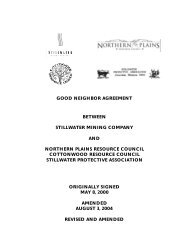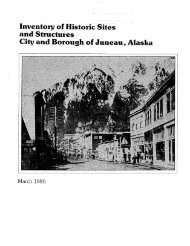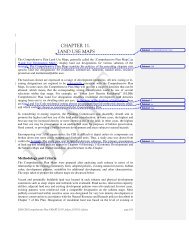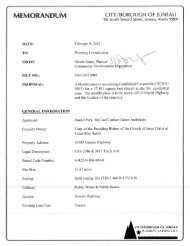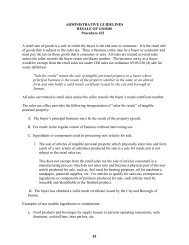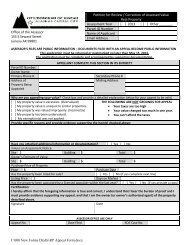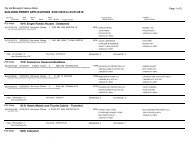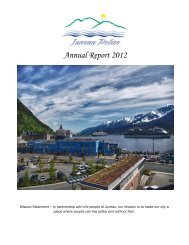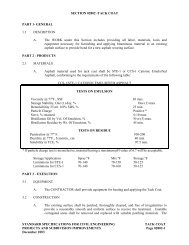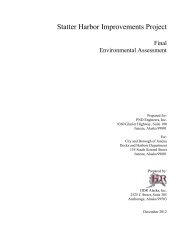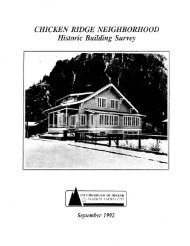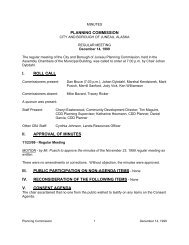Sanitary Sewer Pipe - City and Borough of Juneau
Sanitary Sewer Pipe - City and Borough of Juneau
Sanitary Sewer Pipe - City and Borough of Juneau
You also want an ePaper? Increase the reach of your titles
YUMPU automatically turns print PDFs into web optimized ePapers that Google loves.
SECTION 02401 - SANITARY SEWER PIPE<br />
table is above the sewer throughout the section under test, the ENGINEER may permit<br />
use <strong>of</strong> the Infiltration Test procedure specified hereafter. Where leakage is in excess <strong>of</strong><br />
the specified rate, the sewer shall be repaired by the CONTRACTOR as required to<br />
comply with the leakage test requirements. The ENGINEER may require the<br />
CONTRACTOR to repair obvious leaks even though the total length <strong>of</strong> the test section<br />
falls within the maximum allowable leakage for the test used.<br />
D. For WORK involving replacement <strong>of</strong> existing, active sanitary sewer collection systems,<br />
<strong>and</strong> the new system is not put into service during the same work shift, no Exfiltration/ or<br />
Infiltration Tests will be required. TV inspection <strong>of</strong> the new pipes by the ENGINEER<br />
shall be used to determine system acceptance.<br />
E. Defective pipe joints shall be repaired in a manner that the repaired pipe joint will have<br />
some flexibility <strong>and</strong> the effectiveness <strong>of</strong> the repair will not be affected by differential<br />
movement <strong>of</strong> the adjoining pipes. A "CSSI" or DFW/HPI non-shear coupling, as per<br />
CBJ St<strong>and</strong>ard Detail 218 - Coupling for Dissimilar <strong>Sanitary</strong> <strong>Sewer</strong> <strong>Pipe</strong>s, or approved<br />
equal, will be acceptable in making such repairs.<br />
F. The ENGINEER will make one complete TV inspection after all sewers have passed the<br />
specified watertightness test. All defects regarding sewer alignment <strong>and</strong> grade, damaged<br />
pipe, <strong>and</strong> visible leaks observed during this inspection, shall be corrected by the<br />
CONTRACTOR. The CONTRACTOR shall de-water the sewers as required for the<br />
performance <strong>of</strong> the TV inspection work by the ENGINEER. The CONTRACTOR shall<br />
be responsible for all costs associated with any TV inspection required following the<br />
initial TV inspection, if any defects were observed during this or any subsequent TV<br />
inspections.<br />
G. The hydrostatic test procedure for HDPE <strong>Pipe</strong> shall consist <strong>of</strong> two (2) steps: the initial<br />
expansion phase <strong>and</strong> the test period. In order to accommodate the initial expansion <strong>of</strong> the<br />
pipe under test, sufficient make-up water shall be added to the system at hourly intervals<br />
for three hours to return to the test pressure. The test period begins after the final<br />
addition <strong>of</strong> make-up water in the expansion phase <strong>of</strong> the test procedure. The test period<br />
is three (3) hours. After this test period, a measured amount <strong>of</strong> make-up water shall be<br />
added to return to test pressure. The amount <strong>of</strong> make-up water shall not exceed the<br />
allowable expansion in U.S. gallons shown in the following table:<br />
THREE HOUR TEST<br />
Nominal <strong>Pipe</strong> Size<br />
(Inches)<br />
Allowance for Expansion<br />
(U.S. Gal. Per 100 feet <strong>of</strong><br />
pipe)<br />
8 1.5<br />
10 2.1<br />
12 3.4<br />
16 5.0<br />
18 6.5<br />
STANDARD SPECIFICATIONS FOR CIVIL ENGINEERING SANITARY SEWER PIPE<br />
PROJECTS AND SUBDIVISION IMPROVEMENTS Page 02401-7<br />
December 2003



